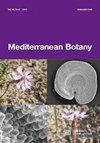Patterns of ecosystem functioning as tool for biological regionalization: the case of the Mediterranean-desert-tropical transition of Baja California
IF 0.7
4区 生物学
Q3 PLANT SCIENCES
引用次数: 3
Abstract
Large-scale ecological variations across Earth have important consequences for biodiversity and, therefore, forbiological conservation. Despite the widespread use of ecological maps in conservation schemes, they have been based mainly on structural and compositional features but scarcely on functional dimensions of life. Incorporating functional variables complements and improves the descriptions of regionalizations and offers a new understanding of biodiversity patterns. The development of remote sensing measurement allows for the description of the functional patterns of ecosystems through Ecosystem Functional Types (EFTs), opening new opportunities to analyze the geography of life. This article aims to examine the relationships between ecological regionalization based on components and structure and patterns of ecosystem functioning. As proof of case, we chose the Baja California peninsula, whose singularity has generated a rich variety of ecological and biogeographical interpretations, mainly based on ecosystem components and structure. We hypothesize that patterns in ecosystem functioning reflect ecoregionalization based on composition and structure features. We identified Ecosystem Functional Types (EFTs), from three descriptors of the seasonal curves of MODIS Enhanced Vegetation Index (EVI) from 2001 to 2017. We characterized each ecoregion in terms of ecosystem functioning and we carried out a correspondence analysis between the EFTs classification and the ecoregions. At a large scale, EFTs showed a pattern with three general regions from northwest to south, capturing the north-south transition of climatic regimes shown in the ecoregions map, from the northwestern Mediterranean area to the southern tropical zone, with a desert transition area between them. However, differences between the functional characterization and some ecoregions were detected in ecoregions identified as discrepancy areas between authors. In particular, some ecoregions considered Mediterranean showed a Desert character in its functioning, and others considered as Desert were Tropical functionally. EFTs remotely sensed measured at regional scales provide the basis for a more comprehensive regionalization of geographical patterns of life and, therefore, an improvement for future conservation purposes.作为生物区划工具的生态系统功能模式:以下加利福尼亚的地中海-沙漠-热带过渡为例
地球上大规模的生态变化对生物多样性有重要影响,因此对生物保护也有重要影响。尽管在保护计划中广泛使用生态地图,但它们主要基于结构和组成特征,而很少基于生命的功能维度。结合功能变量补充和改进了区域化的描述,并提供了对生物多样性格局的新认识。遥感测量的发展使得通过生态系统功能类型(EFTs)描述生态系统的功能模式成为可能,为分析生命地理提供了新的机会。本文旨在探讨基于生态系统功能组成、结构和模式的生态区划之间的关系。作为案例的证明,我们选择了下加利福尼亚半岛,它的独特性产生了丰富多样的生态和生物地理学解释,主要基于生态系统的组成和结构。我们假设生态系统功能模式反映了基于组成和结构特征的生态区域化。利用2001 - 2017年MODIS增强型植被指数(EVI)季节曲线的三个描述符,确定了生态系统功能类型(eft)。我们从生态系统功能的角度对每个生态区进行了表征,并在EFTs分类与生态区之间进行了对应分析。在大尺度上,eft显示了从西北到南的三个一般区域的模式,捕捉了生态区图中所示的气候制度的南北过渡,从地中海西北部到热带南部,两者之间有一个沙漠过渡区。然而,在被确定为作者之间差异区域的生态区域中,发现了功能表征与某些生态区域之间的差异。特别是,一些被认为是地中海的生态区域在功能上显示出沙漠的特征,而另一些被认为是沙漠的生态区域则具有热带的功能。在区域尺度上遥感测量的eft为更全面地划分生活的地理格局提供了基础,因此也为今后的保护目的提供了改进。
本文章由计算机程序翻译,如有差异,请以英文原文为准。
求助全文
约1分钟内获得全文
求助全文
来源期刊

Mediterranean Botany
Agricultural and Biological Sciences-Plant Science
CiteScore
2.40
自引率
10.00%
发文量
30
审稿时长
12 weeks
期刊介绍:
Mediterranean Botany (ISSNe 2603-9109), formerly Lazaroa, is a biannual journal that publishes original research studies in the field of Botany including plant systematics, vegetation ecology, biogeography, evolutionary biology, ecophysiology, community ecology, ethnobotany and conservation biology on Mediterranean biomes but also in interacting areas.
Mediterranean Botany is an OPEN ACCESS Journal, free of charges for any published article.
 求助内容:
求助内容: 应助结果提醒方式:
应助结果提醒方式:


